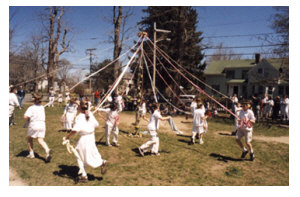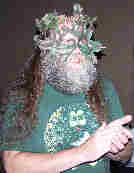|

Fill the Chalice with May Wine
by Brenda Sutton
 Beltane, May Day, one my favorite celebrations of the year, fills our hearts and bodies with lusty joy. My very first May Day celebration was confusing, though. The fourth-grade teacher lined us all up and marched us out to the playground where the janitor had transformed a tether-ball stand embedded in a concrete-filled tire into a May Pole. We all took turns dancing, girls going one way, boys going the other, weaving our colored ribbons in and out. And then we turned the other direction and unwove them. It was fun, but the teacher had no good explanation of why we were doing this. Much later it all came clear. Beltane, May Day, one my favorite celebrations of the year, fills our hearts and bodies with lusty joy. My very first May Day celebration was confusing, though. The fourth-grade teacher lined us all up and marched us out to the playground where the janitor had transformed a tether-ball stand embedded in a concrete-filled tire into a May Pole. We all took turns dancing, girls going one way, boys going the other, weaving our colored ribbons in and out. And then we turned the other direction and unwove them. It was fun, but the teacher had no good explanation of why we were doing this. Much later it all came clear.
A great deal of preparation goes into a Beltane celebration at Oak Spring. The weekend before, we all gather at the covenstead to perform ritual spring cleaning. It's important for the community to clear away all the refuse of the winter, wash the walls, weed the grounds, scour and scrub away the old season. We then have a week to rest up our sore muscles.
On the first of May (or the closest Saturday before it), we return early in the morning bearing armloads of flowers and vines. Daisies, roses, baby's breath, carnations, pinks, lavender, mums, lilies, violets, palm frond, cat's tail, ivy and kudzu. It's usually moist weather, but though it may rain in the morning and afternoon, we've never been rained out in the evening. So, we huddle in the car port creating floral displays for each of the four Quarters — yellows and whites in the East; reds and oranges in the South; blues and violets in the West; and whites and greens in the North. Many create floral wreathes and crowns for their hair. While that's going on, several others are busy bedecking with flowers and vines a wreath that is four feet in diameter; it represents the vulva of the Goddess.
A team of strong folks bring out the May Pole from the barn and remove the ribbons from the previous Beltane, which will be placed as tinder in the ritual bale fire. The pole was a donation from one of our members who had to clear an old 30-foot pin oak from her property. We created our wand from the topmost branch, the May Pole from the trunk, and staves from the limbs. The rest of the tree went into the balefire, the entire tree a sacrifice to the gods.
Out comes the "Ritual Postholer of Art" and we re-dig the same long hole in the center of the dancing area that is used every year. Two long ribbons of white and two of green are measured, two and a half times the length of the pole. These, when nailed in the middle of the May Pole, provide ribbons for four dancing couples. The large, flowery wreath, also suspended from ribbons, is ritually placed over the top of the pole and nailed into place. There's alway lots of mock grimacing from the menfolk at each hammer blow.
Finally, the pole is capped by a 2-foot long, brilliant green, papier mache penis, which was lovingly crafted by the ladies of the coven during one of our first Women's Mysteries. I top the "Jolly Green Giant" with a sprig of baby's breath. Then the men plunge the pole into the hole. There can be no doubt that THIS is a FERTILITY SYMBOL! (We tell our neighbors in the Baptist church next door that we're having a wedding — and we are. It has long been considered unlucky to marry in the month May because that time was reserved for the wedding of the Gods. Even the sensible Queen Victoria forbade any of her children from marrying in May. June became the month for marriage.)
Now folks take a few moments to contemplate the coming year. They take strips of parchment and write the wishes of their hearts, tying them to the May Pole with brightly colored ribbons. The higher up the pole, the more likely that the wish will be plaited in with the energy of the pending dance. Most folks then head home to clean up, prepare food for the feast, take ritual baths, and return later that night robed for ritual in tabards and cloaks of white or green.
Beltane, like its cross-quarter Samhain, is a mighty transition point. The God and Goddess are the true King and Queen of the May. The God, reborn at Yule, has reached His youthful maturity. The Goddess, quickened from Crone to Maiden at Imbolc, is fertile and beautiful. He offers to lay the Sword of Power at Her feet, but She takes His hands before it touches the ground and requests His strength. Together, they raise the Sword between them, kiss beneath it. She takes the Sword, the season turns, and the reign of the Goddess begins.
 Cakes and wine are passed around the circle. The ritual wine inside the chalice can be many things during the year — water, milk, beer, cider — but at Beltane it is either May Wine or Honey Mead. The Maibowle is made by adding the herb called sweet woodruff to dry white wine. The flavor is delightful and distinctive and hard to describe. Cakes and wine are passed around the circle. The ritual wine inside the chalice can be many things during the year — water, milk, beer, cider — but at Beltane it is either May Wine or Honey Mead. The Maibowle is made by adding the herb called sweet woodruff to dry white wine. The flavor is delightful and distinctive and hard to describe.
Start with one bottle of white wine (a good Sauterne, Moselle, or Rhine wine works well) and a cup of brandy. The trick is to use thirteen sprigs of dried sweet woodruff in a cheesecloth bag. The drying process enhances the cumarin flavor in the herb; fresh sprigs won't add any flavor at all to the wine. Some folks add sweet syrup or a cup or two of powdered sugar, but I prefer my May Wine straight. Let the mixture soak and chill for at least an hour. Then remove the woodruff and toss in thirteen large sliced strawberries. Add a few cups of champagne at the last minute to sparkle it up, if you like.
Honey Mead, on the other hand, takes a good long time to produce, sometimes a year or more. The word 'mead' comes from the Welsh meddyglyn, meaning "medicinal liquor". Raw honey was often smeared on open wounds for its antiseptic properties. Healing herbs were stored for the winter as metheglin, and were certainly much easier to swallow. 'A spoon full of mead makes the medicine go down...' yes, it does.
The first description of mead is found in the ancient Indian religious book, the Rigveda. Mead (like beer) was often much safer to drink than water, however mead can also be much more dangerous to drink than water for entirely different reasons. Wink, wink, nudge, nudge, say no more.
 I once took a mead-making seminar from John Monogue. (If you attended Mythic Journeys '06, you'll remember John as the large man sporting the bushy beard and Green Man mask.) He started by telling us that he'd had a bit of trouble coming up with enough information on mead-making to fill a hour-long class — it's just such a simple process. I once took a mead-making seminar from John Monogue. (If you attended Mythic Journeys '06, you'll remember John as the large man sporting the bushy beard and Green Man mask.) He started by telling us that he'd had a bit of trouble coming up with enough information on mead-making to fill a hour-long class — it's just such a simple process.
"You dissolve 4 pounds of raw, unfiltered honey into two quarts of spring water and boil for 15 minutes, skimming the white gunk. Mix this solution with water to make a gallon of 'must'. Add fruits, berries or spices. If you like the natural taste, you'll probably also like the taste in mead. Pitch in champagne or brewer's yeast when the 'must' comes to room temperature. The yeasties will start to eat the sugars, and burp gas. The whole mixture bubbles happily away. When the burping starts to slow, rack it off to separate any sediment. Bottle the stuff when it settles and clears. Then put it in the corner...and wait for six months to a year. Open a jar and taste it. If you like it, drink it. If you don't like it, close the jar, put it back in the corner and wait a few months. Open it up and taste it. If you like it, drink it. If you still don't like it, close the jar, put it back in the corner and wait a few more months. If, when you open it the third time, you still don't like it, pour it out and start over." The longer you let it sit, the better your chances of getting a wicked-smooth mead. Three years — magnificent! And the alcohol content of the stuff can put you on your backside in no time flat.
To fill out the remaining time in the seminar, John then proceeded to break open and pass around jar after jar after jar of some of his concoctions that "tasted pretty good." We sent the jars around the table several times, sampling and trying to discern the differences in flavors and potency. By the end of the hour we were all in agreement — this was the most informative seminar we'd ever taken and, by the Gods, we must have that seminar again!
Here's a quaint custom that I'd like to see revived. It once was traditional for the newly-married couple to receive a cask of Honey Mead as a wedding gift from the bride's father. Off the happy couple went to celebrate their honeymoon — a month wherein they drank the contents of the cask. As long as there remained some mead in the cask, the couple was to be left alone. When it was empty, they returned to the community and resumed their normal responsibilities as husband and wife.
So...back to our Beltane ritual...the Sword of Power has changed hands, and we've all eaten something delicious and whet our whistles with May Wine or Honey Mead. Now the revelry begins!
We stoke the bale fire in the center of the circle — get the flames good and high. Then I deliver the annual warning:
"We jump the bale fire for FER-TI-LI-TY. It is old and potent magic, which like grass growing up through the cracks, will find a way to manifest. I've seen several 'Beltane babies' enter this world. So, if you don't plan on creating a child, then have the image of whatever you do want to come to fruition planted FIRMLY in your mind. Otherwise, Nature will default to the most natural use of the energy."
Couples join hands in the East, the Quarter of Birth and Inspiration, to leap over the fire with resounding Harriayahs!, landing in the West, the Quarter of Emotion and Manifestation. If someone isn't capable of leaping, we drag a few coals out of the fire that can be stepped over.
 Then we all process to the torch lit dancing area and the May Pole. Then we all process to the torch lit dancing area and the May Pole.
Not just anyone can participate in the May Pole Dance, no — we carefully choose only couples who are in loving and committed relationships. The magic that gets danced around that pole charges the entire covenstead, but definitely affects those dancers. I try to pick healthy, strong, energetic couples, too, because the dance is long and lively.
The men hold high their white ribbons and face deosil (clockwise), the direction of action and energy building. The women hold low their green ribbons and face widdershins (anti-clockwise), the direction of receptivity. Then we start the chant...veeeerrrrry sssslllloooowwwlllyy. What chant did the ancients use? Who knows! We practice an oral tradition with few surviving records — but Pagans are a practical people who appreciate a good rhyme. We use a piece by Rudyard Kipling and it works well for our needs:
Oh, do not tell the Priest our plight,
Or he would call it a sin;
But—we have been out in the woods all night,
A-conjuring Summer in!
And we bring you news by word of mouth—
Good news for cattle and corn—
Now is the Sun come up from the South,
With Oak, and Ash, and Thorn!
The women duck under the arm of their partner and then raise their arm for the approaching man to duck under. Around and around they go while the chanting builds in speed, intensity and volume. The couples start to run to keep equidistant from each other, urged on by the crowd and the energy. As the green and white ribbons plait down over the multicolored wish-ribbons on the pole, the feel of the dance changes. Bodies are writhing close to each other. Up, down, in, out, round and round, until they can no longer duck under another arm. The final "Harriayah!" ends the dance. Then I approach the pole to tie off the ribbons, white to green. All participants are red-faced and winded at its conclusion.
Then we all step back and stare up at our May Pole — wrapped with energy and passion, hope and love— to scry the coming year by the even or uneven plaiting. "Oh, smooth going through the summer, but there's a rough patch as fall approaches. Not a bad winter though." There was one very difficult year when one of the women ran the wrong direction. (shudder)
In the old days, the priest and priestess, the couples from the May Pole Dance, and any other couples who felt so inclined took the energy and moved it out into the fields for long and lusty copulation, sympathetic magic to show the earth our prayer for fertility of crops. Nowadays, we feast and drink into the wee hours of the morning, most of us taking our passions homeward to our own comfy beds, but I wouldn't be surprised to see a young couple grab a cloak and slip off down one of our woodland paths. It's Beltane! The celebration of the consummation of the Gods.
Consummation. I love that word. To consume, as fire consumes wood producing heat and flame. To consume, as we consume delicious food, sweet mead, hungry mouths. To consummate, to be consumed in mating as we join passions and bodies for the creation of the next generation. To be consumed with love, joy and beauty, the Divine Three, and as we do will, so mote it be!
Happy Beltane!
 Listen to May Queen Listen to May Queen
by Three Weird Sisters (96K)
 Brenda Sutton is the publisher of Mythic Passages, Operations Director, Corporate Secretary, and Office Administrator for Mythic Imagination Institute. She is an award-winning singer/songwriter with the internationally reknown band Three Weird Sisters. She works in a support and consultant capacity for the non-profit music organization Interfilk, and maintains their website. She is freelance writer whose work has appeared in newspapers and magazines. She is also the mother of five, grandmother of two.
Brenda Sutton is the publisher of Mythic Passages, Operations Director, Corporate Secretary, and Office Administrator for Mythic Imagination Institute. She is an award-winning singer/songwriter with the internationally reknown band Three Weird Sisters. She works in a support and consultant capacity for the non-profit music organization Interfilk, and maintains their website. She is freelance writer whose work has appeared in newspapers and magazines. She is also the mother of five, grandmother of two.
Return to Passages Menu
Subscribe to the Passages e-zine
|

